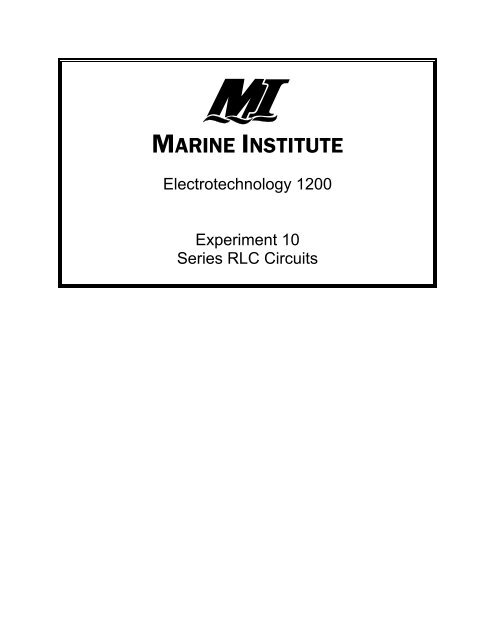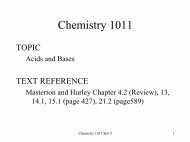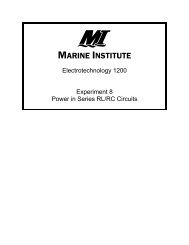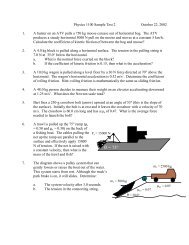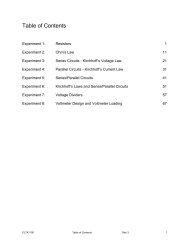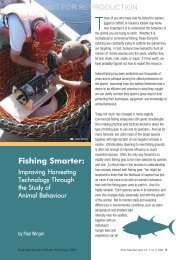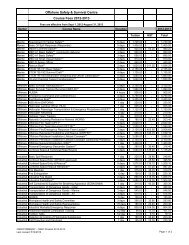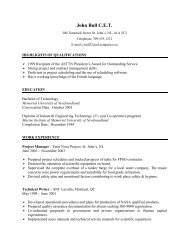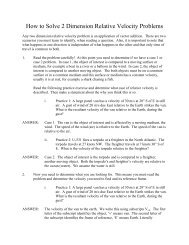Electrotechnology 1200 Experiment 10 Series RLC Circuits
Electrotechnology 1200 Experiment 10 Series RLC Circuits
Electrotechnology 1200 Experiment 10 Series RLC Circuits
Create successful ePaper yourself
Turn your PDF publications into a flip-book with our unique Google optimized e-Paper software.
<strong>Electrotechnology</strong> <strong>1200</strong><strong>Experiment</strong> <strong>10</strong><strong>Series</strong> <strong>RLC</strong> <strong>Circuits</strong>
SAMPLE CALCULATIONSELTK<strong>1200</strong> <strong>Experiment</strong> <strong>10</strong> Rev 5 1<strong>10</strong>
BASIC INFORMATIONThe analysis of series <strong>RLC</strong> circuits is the same as series RC and RL circuits, except themagnitudes of X C and X L must be taken into account. If X C > X L , then the circuit iscapacitive (leading phase angle). If X L > X C , then the circuit is inductive (lagging phaseangle). If X L = X C , then the circuit is resistive (no phase angle). This is a special case, andthe frequency that it occurs at is called resonant frequency.The phasor diagram, impedance triangle and power triangle for a series <strong>RLC</strong> circuit, whichis capacitive (I leads V S by θ), looks like this:This <strong>Experiment</strong> attempts to prove the affect frequency has on these relationships in aseries <strong>RLC</strong> circuit.ELTK<strong>1200</strong> <strong>Experiment</strong> <strong>10</strong> Rev 5 111
OBJECTIVESWhen you have completed this exercise, you should be able to:CCCCCVerify impedance relationships in a series <strong>RLC</strong> circuit.Verify voltage relationships in a series <strong>RLC</strong> circuit.Determine experimentally the resonant frequency for a series <strong>RLC</strong> circuit.Draw the impedance triangle for a series <strong>RLC</strong> circuit.Draw the phasor diagram for a series <strong>RLC</strong> circuit.FORMULAEFormula 12.Formula 16.Formula 28.Formula 45.Formula 46.EQUIPMENT & MATERIALS REQUIREDOscilloscope.3 BNC to Alligator Clip test leads.1 Black Alligator Clip to Banana Plug test lead.1 Red Alligator Clip to Banana Plug test lead.Isolation transformer (Black).BK Precision 5MHz Function Generator.Orange Project board (stored in Bench Cabinet).DMM (Digital Multimeter).470Ω resistor.25 mH (or 50mH or 30mH) choke (handed out at start of experiment).• Record this value in Table <strong>10</strong>-1 (end).2 0.1μF Capacitors.Miscellaneous Quick Clips.ELTK<strong>1200</strong> <strong>Experiment</strong> <strong>10</strong> Rev 5 112
PROCEDURE A (Frequency Response of a <strong>Series</strong> <strong>RLC</strong>Circuit)A1. Measure the actual resistance of the 470Ω resistor and the dc resistance of the 25mH choke and calculate the total series resistance [<strong>10</strong>-1].A2. Connect the Isolated Function Generator circuit shown in Figure 2-1 (pg. 17) to thecircuit of Figure <strong>10</strong>-1. Prepare to measure V CD PP , V R PP , V L PP and V C PP (individually).Figure <strong>10</strong>-1A3. MODE to CH-A(CH1).A4. Turn the Function Generator ON and set V CD to 6V PP , <strong>10</strong>00Hz.A5. Measure V R PP , V L PP and V C PP [<strong>10</strong>-2] using CH-A.A6. Calculate the current I, the inductive reactance X L , the capacitive reactance X C andthe phase angle θ [<strong>10</strong>-2]. Indicate if θ is leading or lagging.Note: Use R T when you calculate the phase angle θ.A7. Complete Table <strong>10</strong>-2 for each frequency shown.A8. Turn the Function Generator OFF, but do not change the circuit. It will be used inProcedure B.ELTK<strong>1200</strong> <strong>Experiment</strong> <strong>10</strong> Rev 5 113
PROCEDURE B (Determining resonant frequency)B1. MODE to DUAL, SOURCE to INT and PULL INVERT is pushed IN.B2. To the circuit in Figure <strong>10</strong>-1, connect the oscilloscope to measure V R PP vs V CD PP .B3. Adjust V CD PP = 6V PP .B4. Switch CH-A and CH-B AC-GND-DC toGND. You will get two horizontal lines.Adjust VERTICAL POSITION to positionthe lines on the X-axis.Switch CH-A and CH-B AC-GND-DC toDC. Your waveforms should be centeredon the X-axis. The waveforms will be outof phase with each other, similar to thedrawing on the right.B5. At resonant frequency f R , X L = X C , and V Swill be in phase with the current I.Therefore if you adjust frequency until V R isin phase with V CD , you can determineresonant frequency.B6. Increase/decrease the frequency toattempt to get waveforms similar but notthe same as the ones shown on the right.As you adjust the frequency, examine bothwaveforms as they cross the X-axis. Makeyour frequency adjustments to bring thesepoints to the same place. Then they will bein phase.As you change frequency, adjust TIME/DIV and CH-A/CH-B VOLTS/DIV to keep 1-3waveforms on the screen.B7. Record the resonant frequency f R [<strong>10</strong>-3].B8. On pg. 1<strong>10</strong>, calculate the theoretical resonant frequency for these components.ELTK<strong>1200</strong> <strong>Experiment</strong> <strong>10</strong> Rev 5 114
B9. Disconnect the scope. MODE to CH-A(CH1).B<strong>10</strong>. Measure V R PP , V L PP and V C PP [<strong>10</strong>-3].B11. Calculate the current I, the inductive reactance X L , the capacitive reactance X C andthe phase angle θ [<strong>10</strong>-3].B12. Adjust the frequency to f R - <strong>10</strong>00Hz. Repeat Steps B<strong>10</strong> to B11.B13. Adjust the frequency to f R + <strong>10</strong>00Hz. Repeat Steps B<strong>10</strong> to B11.B14. Turn the Function Generator OFF.B15. Add a second 0.1μF capacitor in parallel as shown in Figure <strong>10</strong>-2.Figure <strong>10</strong>-2B16. Repeat Steps B2 to B14 for the circuit in Figure <strong>10</strong>-2.B17. Turn the Function Generator OFF. Disconnect your circuit and return all equipmentto its proper place.ELTK<strong>1200</strong> <strong>Experiment</strong> <strong>10</strong> Rev 5 115
ELTK<strong>1200</strong> <strong>Experiment</strong> <strong>10</strong> Rev 5 116
RESULTSTable <strong>10</strong>-1RmeasR DC of LmeasR T = R + R DCcalcLgivenMeasuredStep A1 StartTable <strong>10</strong>-2fHzV CD PPmeasV R PPmeasV L PPmeasV C PPmeasIcalcX LcalcX Ccalcθcalc<strong>10</strong>00 6V PP2000 6V PP2500 6V PP3000 6V PP4000 6V PP5000 6V PPStep A4,7 A5 A6Table <strong>10</strong>-3fmeasV R PPmeasV L PPmeasV C PPmeasIcalcX LcalcX Ccalcθcalcf Rf R - 1kHzf R + 1kHzf Rf R - 1kHzf R + 1kHzStep B7 B<strong>10</strong> B11TIPI is RMS.ELTK<strong>1200</strong> <strong>Experiment</strong> <strong>10</strong> Rev 5 117
QUESTIONS1. On pg. 116, using the data from Table <strong>10</strong>-2, graph current vs frequency, inductivereactance vs frequency and capacitive reactance vs frequency. Frequency is thehorizontal axis. Current is the vertical axis on the left and reactance is the verticalaxis on the right. For your data, draw lines of best fit.2. Using the data from Table <strong>10</strong>-3, draw the phasor diagram and impedance trianglefor f R for one 0.1μF capacitor.3. Using the data from Table <strong>10</strong>-3, draw the phasor diagram and impedance trianglefor f R - 1kHz for one 0.1μF capacitor.4. Using the data from Table <strong>10</strong>-3, draw the phasor diagram and impedance trianglefor f R + 1kHz for one 0.1μF capacitor.5. You found f R by using a scope to determine when V R was in phase with V S . Usingyour data from Table <strong>10</strong>-2, can you determine 3 other methods to experimentallydetermine the exact resonant frequency.Hint: Compare the data in Table <strong>10</strong>-2 and <strong>10</strong>-3 or check the graphs of Question 1.ELTK<strong>1200</strong> <strong>Experiment</strong> <strong>10</strong> Rev 5 118


